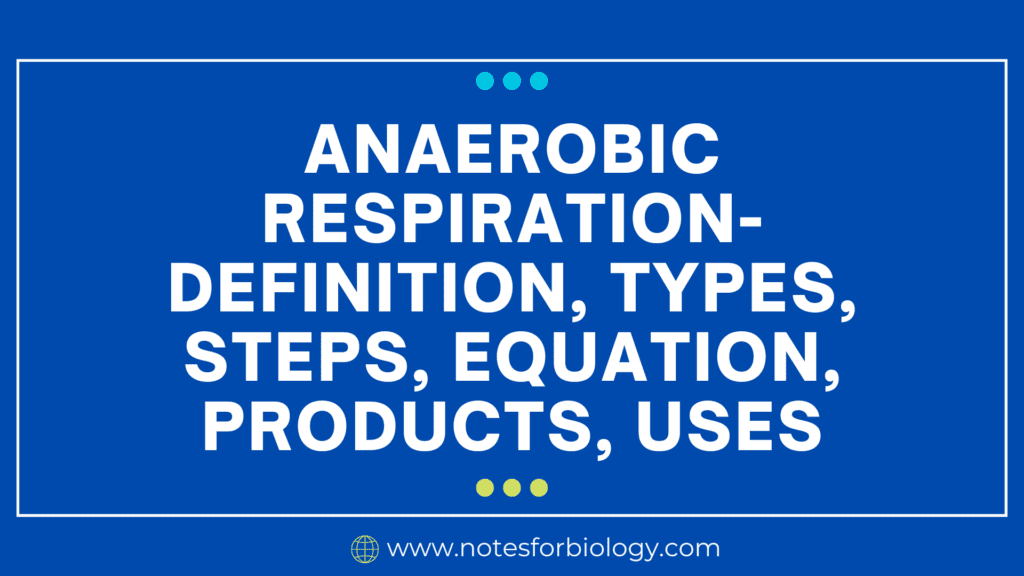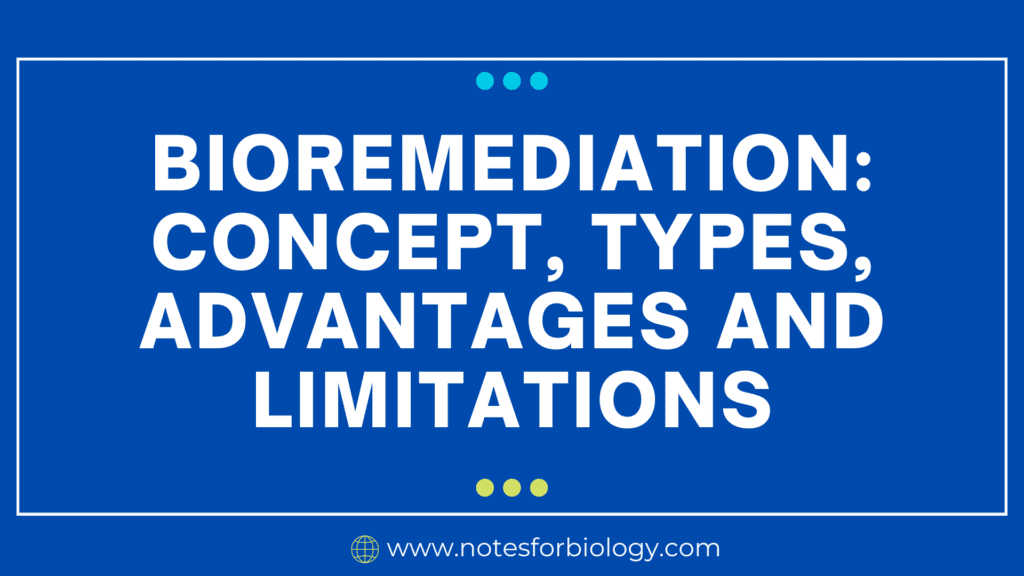Respiration is a basic biological process which allows organisms to release waste products while converting biochemical energy from nutrients into adenosine triphosphate (ATP). Anaerobic respiration is the process that takes place when oxygen is not present, whereas aerobic respiration happens when oxygen is present. There are two main types of respiration. They are:
- Aerobic Respiration
- Anaerobic Respiration
Table of Contents
What is Anaerobic Respiration?
Anaerobic respiration is a form of respiration in which oxygen is not present. Certain microbes and cells use it as a method of energy production so they can live and work in conditions with little or no oxygen. Yields of ATP and energy that are obtained without the use of molecular oxygen are always lower. The list of alternative electron acceptors is long and includes some organic compounds (such as dimethylsulfoxide, fumarate, and trimethylamine oxide), the oxidized forms of metals (such as Fe3+ and Mn4+), and the oxyanions of numerous elements (such as arsenate, nitrate, nitrite, perchlorate, selenate, sulfate, and uranate).
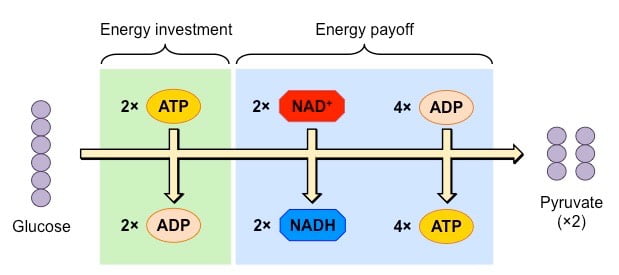
There are several types of anaerobic respiration, depending on the electron acceptor used:
1. Lactic Acid Fermentation
Lactic acid fermentation, is a type of respiration that takes place without oxygen and is frequently observed in bacteria like Lactobacillus and in muscle cells during vigorous exercise. Glycolysis is the first step in this process that breaks down glucose to produce pyruvate, which is subsequently reduced to lactic acid. In order for glycolysis to continue generating ATP, NAD⁺ must be replenished through this reduction. Two ATP molecules are produced for every glucose molecule during lactic acid fermentation, which offers a rapid but constrained source of energy during oxygen shortages.
Equation: Glucose + ADP + NADH → Lactic acid + ATP + NAD+
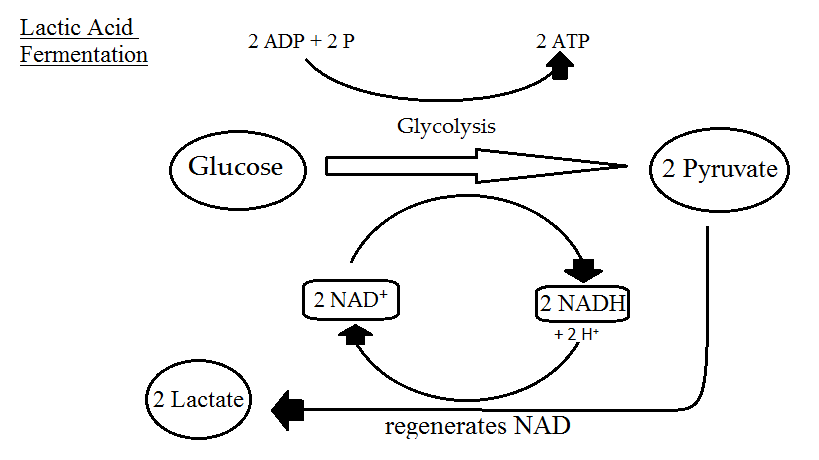
2. Alcoholic Fermentation
Yeast and some other bacteria use alcoholic fermentation, a form of anaerobic respiration, to produce energy when there is no oxygen present. This process breaks down glucose into pyruvate, which is subsequently transformed into carbon dioxide and ethanol through the process of glycolysis. Pyruvate is decarboxylated to acetaldehyde, which releases CO2; acetaldehyde is then reduced to ethanol in two stages of this conversion process. By replenishing NAD⁺, alcoholic fermentation permits the production of ATP through glycolysis. Yeast ferments sugars to produce ethanol and CO2 in alcoholic beverages like wine and beer. This process is known as alcoholic fermentation, and it is used in many different industries.
Equation: Glucose + ADP + NADH → Ethanol + ATP + NAD+
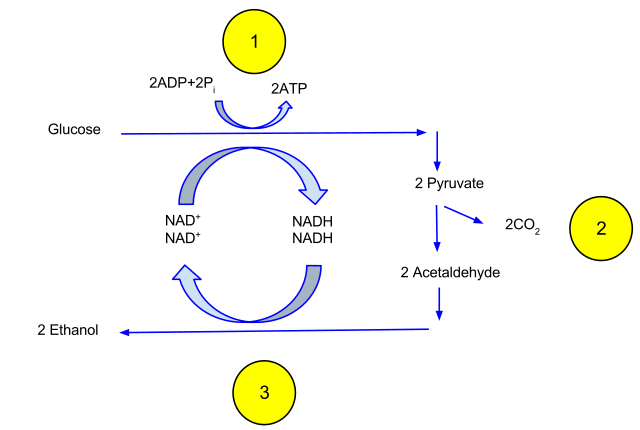
Steps of Anaerobic Respiration
There are two main steps involved in anaerobic respiration: fermentation and glycolysis.
A. Glycolysis
A fundamental component of cellular metabolism, glycolysis is a process that is present in all living forms, including bacteria and humans. It is the first stage of cellular respiration, whether it is anaerobic or aerobic, and it transpires in the cytoplasm. The first step in the pathway is the phosphorylation of glucose to glucose-6-phosphate, which sets up the sugar for further changes. Ultimately, glucose splits into two molecules of pyruvate through a sequence of enzymatic reactions, producing trace amounts of ATP and NADH in the process. Glycolysis is anaerobic, meaning it doesn’t depend on oxygen being available to function.
Equation: Glucose + 2 ATP + 2 ADP + 2Pi + 2 NAD+ → 2 Pyruvate + 2 NADH + 2 ATP
B. Fermentation
There are various pathways involved in fermentation, which vary based on the organism and surrounding conditions. Pyruvate is transformed into lactate in animals and certain microbes, including bacteria. This process involves the reduction of pyruvate by NADH, forming lactate and NAD+, and is catalyzed by lactate dehydrogenase.
Pyruvate is transformed into ethanol and carbon dioxide by other organisms such as yeast and certain bacteria. Two important enzymatic reactions are involved in this pathway. First, pyruvate is converted into acetaldehyde by pyruvate decarboxylase, which releases carbon dioxide. Next, NADH reduces acetaldehyde to produce ethanol while also regenerating NAD+. This fermentation process is used in industrial processes like baking bread and in the manufacturing of alcoholic beverages.
Equation: C6H12O6→2CH3COCOO−+2H2O+2H+
Products of Anaerobic Respiration
Anaerobic respiration produces a variety of products based on the organism and metabolic pathways involved in the process, which takes place in the absence of oxygen. Lactic acid is produced by anaerobic metabolism in animals and certain microorganisms, including bacteria. Lactate dehydrogenase, which produces NAD+ from NADH, reduces pyruvate to lactate during this process, which is referred to as lactic acid fermentation. On the other hand, anaerobic respiration in yeast and some bacteria results in alcoholic fermentation, which produces ethanol and carbon dioxide. This pathway reduces pyruvate to ethanol after it has been decarboxylated to acetaldehyde, which releases carbon dioxide. These fermentation processes allow organisms to maintain glycolysis and ATP production in oxygen-poor environments, making them vital adaptations.
Uses
- Energy Production: Anaerobic respiration enables the synthesis of ATP to meet cellular energy demands in organisms living in environments with little to no oxygen availability. Even though it’s not as effective as aerobic respiration, anaerobic survival is still possible with it.
- Muscle Function: To maintain ATP production during vigorous exercise, muscle cells turn to anaerobic respiration when oxygen demand exceeds supply. This allows for brief energy bursts, like sprinting or weightlifting, even in the face of transient oxygen shortage.
- Fermentation: An essential component of the fermentation processes used to produce food and beverages is anaerobic respiration. For instance, yeast undergoes anaerobic respiration during the brewing of beer and the baking of bread to produce ethanol and carbon dioxide, which enhance flavor and texture.
- Bioremediation: To remove pollutants from the environment, certain anaerobic microorganisms are used in bioremediation processes. In oxygen-poor environments, these organisms can break down organic compounds, which helps reduce pollution in the soil and water.
- Industrial Applications: The production of biofuels like ethanol and biogas is one of the many industrial processes that use anaerobic fermentation. It is possible to engineer microorganisms to metabolize organic matter anaerobically, producing useful products for the production of energy.
Frequently Asked Questions(FAQ)
What is anaerobic respiration, and how does it differ from aerobic respiration?
Anaerobic respiration is a metabolic process that produces energy for cells when it takes place without oxygen.
It differs from aerobic respiration, which produces ATP more effectively and needs oxygen.
What are the advantages and disadvantages of anaerobic respiration?
By producing fast energy, anaerobic respiration enables organisms to live in oxygen-poor conditions. When compared to aerobic respiration, it is less effective and may result in the accumulation of hazardous byproducts.
Related Articles:

